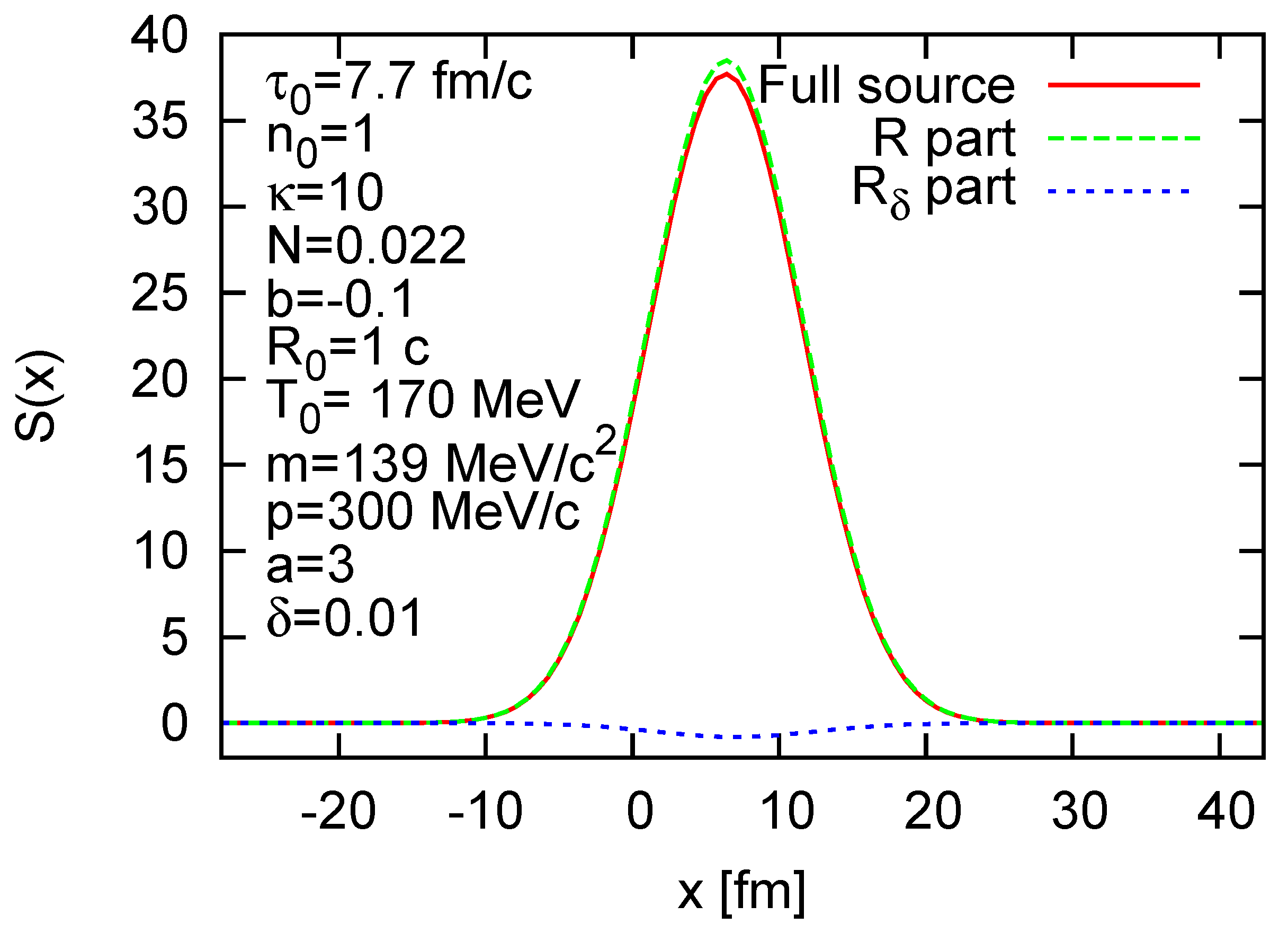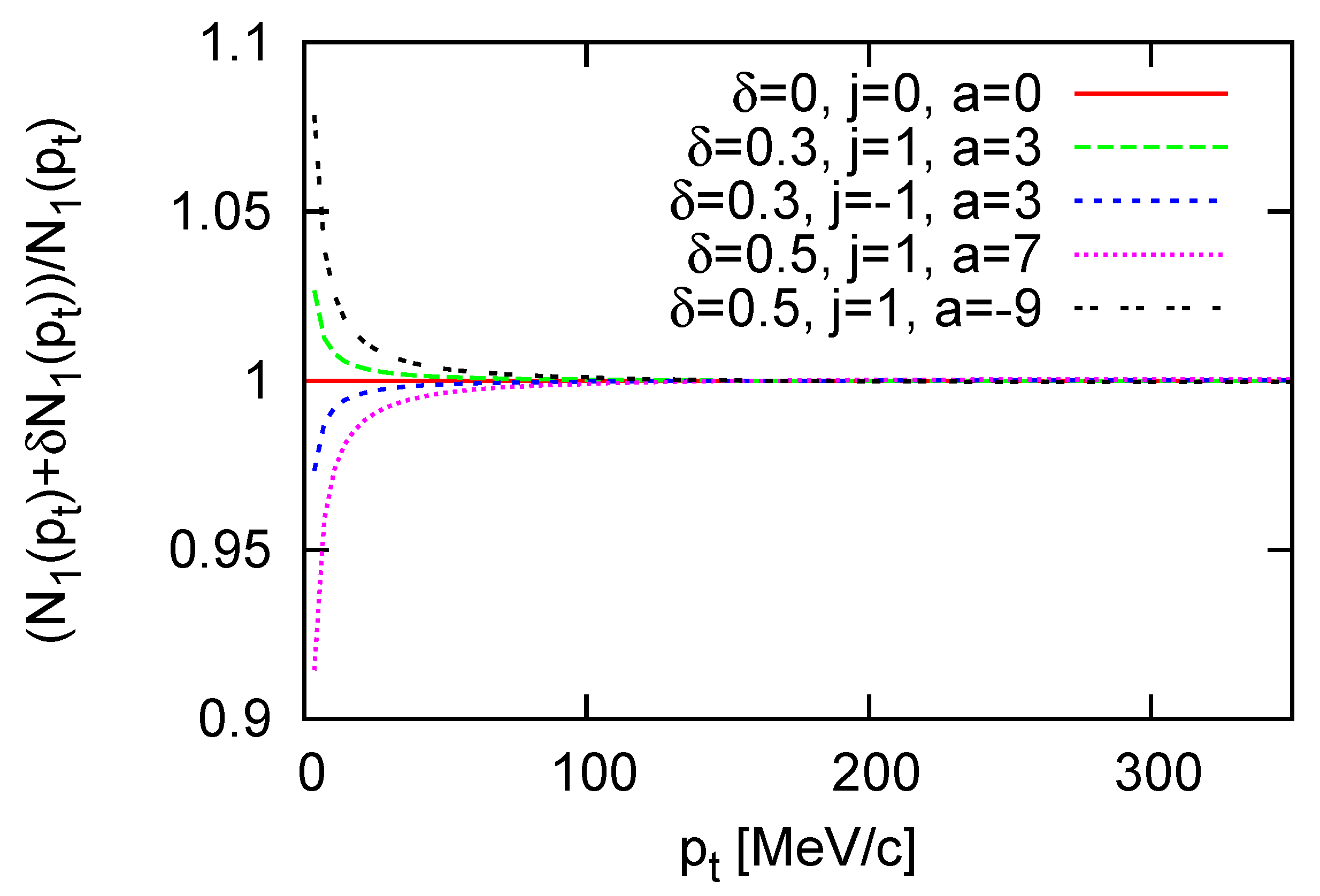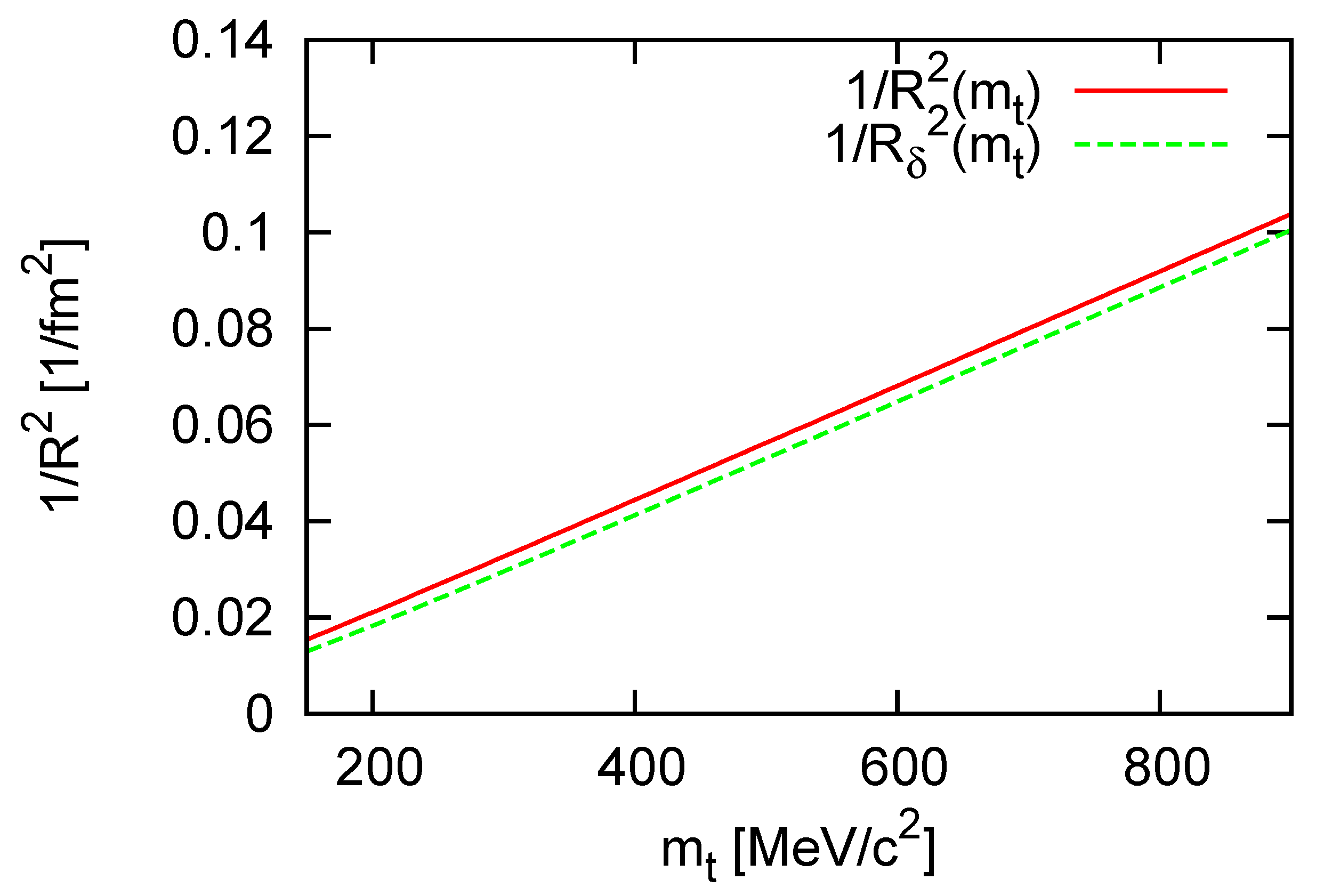2. General Equations
We are using the equations of relativistic perfect fluid hydrodynamics. This can be formulated as the following:
where
is the energy-momentum tensor, which can be expressed with the four-velocity
, pressure
p and energy density
; and is the following for perfect fluids:
We denote the Minkowskian metric tensor by
, and we use
notation. In addition, we use a simple equation of state (EoS), where energy density is proportional to pressure, and
is constant:
With this EoS the equations of relativistic hydrodynamics can be separated into the following Euler equation and energy equation:
Finally, we assume that there is a conserved charge density (
n), therefore we can formulate a continuity equation for this conserved quantity:
4. Calculation of Observables
In heavy-ion collisions, the velocity field, pressure and energy density can not be measured directly. Let us now investigate the quantities that can be measured in heavy-ion collisions and calculated from hydrodynamical solutions. For this we assume that the particles come from a thermalized medium of quark-gluon plasma and this can be characterized by a source which comes from a relativistic Jüttner-distribution similarly as in [
3,
6]. Also, we assume a constant freeze-out hypersurface in proper time at
. The temperature of the system is defined through the following equation:
. For the pertubative handling we will have to calculate the first order perturbation of this source function. For the most general set of perturbations of the Hubble-flow described in Equations (11) and (13) the source function has the following form:
where
N is a normalization factor, and
is the four-momentum of the outgoing particles. For further studies we use a Gaussian approximation of the source. This means that we write the source as the product of a Gaussian peak and some other terms. By performing the proper time integral we can study the spatial dependence of the source. In the case of the concrete solution described in
Section 3.3 the source becomes a two component Gaussian:
With
corresponding to the perturbative terms:
with
r being the radial distance
and
being the following function:
The
,
have the following form in the Gaussian-approximation:
Here, the
R and
describe the widths of these Gaussian parts of the source. A visualization of the source can be seen in
Figure 1. We can see, that the
term, which has the width
gives a negative contribution to the source with the chosen set of parameters, however the sign of the perturbative peak depends on the choice of parameters and could yield a positive gain.
Furthermore,
and
are effective temperatures, corresponding to the inverse logarithmic slope of the Maxwell–Boltzmann like distributions.
R and
are the same as in the original Hubble-flow, while
and
give the perturbative corrections to the Gaussian width and the effective temperature. The newly introduced notations are the following:
From the source function, the single-particle momentum distribution can be calculated:
To perform this integral analytically we use the Gaussian saddlepoint approximation. In general, we have the integrand in the form of
, where
is slowly changing, and
has a sharp, unique peak at
:
From this we can easily get the final form of the single-particle momentum distribution:
Here, we introduced the following functions:
The terms which come from the first order perturbations are denoted with
and are of the following form in this concrete case of the solution with a saddlepoint approximation:
Looking at the final form of the momentum distribution we can see that it is spherically symmetric as we have expected from the spherically symmetric solution.
5. Discussion
To understand the role of perturbations on top of the original Hubble-flow we can plot the calculated quantities with given values of parameters. For this we use model parameters of the Hubble-flow from [
3] where quantities calculated from the exact solution were fitted to the experimental data. With these parameter values we can study the role of acceleration in this concrete solution and the role of the
a,
and
j parameters. We can see from Equations (
25) and (29) that the source and the invariant momentum distribution does not depend separately on
or
j, but on their product
. Also, the form of scale parameter does not affect the observables directly, therefore, we can not study the role of these parameters independently: Their product defines the scale of the perturbations. In
Figure 2 we can see the ratio of the original and the perturbated transverse momentum distributions at different values of the
a and
parameters with the Gaussian saddlepoint approximation. It can be seen that with this approach, the perturbations only give small corrections to the low momentum region of the single particle momentum distribution.
However, the saddlepoint approximation might not give back all the properties of the perturbation, as it assumes that the function that multiplies the Gaussian peak is slowly changing. In our case we can see from Equations (
25) and (29) that we have terms proportional to
that might influence the result, as
. Therefore we could make a Laurent-expansion of the terms
; as it turns out the series is finite in the negative region with all the terms vanishing below
, which indicates that all the terms are integrable. This approach gives rise to rather complicated integrals and we will not discuss this method further, we simply wanted to note the possibility of such a calculation in the future. For this type of calculation, it is however sufficient to use the saddlepoint calculation, as it provides a good approximation of the results if the requirement
is met, but
is not.
Let us now turn to study the geometry of the particle emitting source. From femtoscopic measurements, the homogeneity region of the source can be mapped out. The first intensity correlation measuruments were carried out by R. Hanbury Brown and R. Q. Twiss, thus these are often called HBT measurements [
7]. The size of the source can be characterized by the HBT-radii, which are often associated with the Gaussian widths of the source [
8,
9]. However, let us note here that there are more general approaches to characterize the source [
10,
11]. In this paper, we have used a Gaussian approximation for the analytic calculations, therefore we can associate the Gaussian width of the source with the HBT-radius of the studied, spherically symmetric system. The source is the sum of two terms with different widths. This gives us two different HBT-radii,
R and
, where
R is the same as it is for the exact solution [
3]. The HBT-radius of such a source is some average of the radii
R and
.
The values of
R and
do not depend on the perturbation parameters
,
j and
a, but their averaging does depend on the choice of these. For such model parameters as used for
Figure 2 the average HBT-radius is approximately the same as the original
R, and only for large
and
a values do we get a significant contribution from
. We can look at the HBT-radius as the function of the transverse mass:
. Experimentally the HBT-radii usually show a scaling, regardless of particle species, collision energy or centrality [
8,
9]. The cause of this scaling is the hydrodynamical expansion both in the longitudinal and the radial directions [
12]. We can see the
scaling in
Figure 3 as it was already shown in [
6].
6. Summary
We have given the perturbated source function for the perturbative, accelerating generalization of the exact Hubble-flow, and calculated the single-particle momentum distribution and the HBT-radius for a spherically symmetric solution. This way the solution includes the acceleration and pressure gradient. For the observables we have found that the perturbations cause only small deviations from the original quantities in the Gaussian saddlepoint approximation. Also, we have seen that the source is a sum of two Gaussians with different widths. Furthermore, we have found that the choice of scale parameter does not affect the calculated observables directly, but results only in a difference in the perturbation scale. For further studies, the elliptical flow could be also calculated, but in a non-spherically symmetric case.








